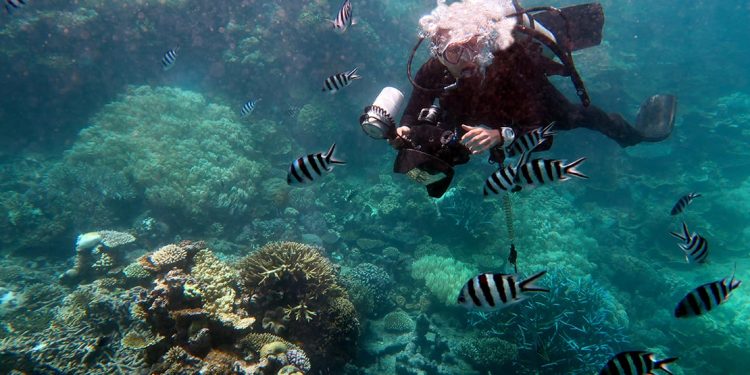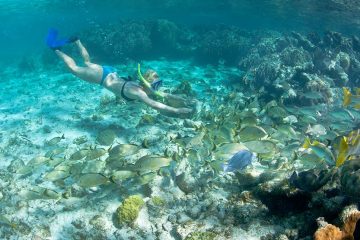
Dive Deep Into the Blue
When it comes to diving, it can be difficult to choose the very best places to scuba dive in the world, as it really depends on an individual’s preference. Perhaps you want caverns, shipwrecks, drift dives, underwater scenery, exotic fish, giant creatures or a little of all of the above.
No matter what your particular desires, however, these sites offer some of the most exceptional diving experiences on the planet.
Great Barrier Reef, Australia
There are few better places than the Great Barrier Reef to experience a spectacular underwater world. Here it seems nature decided to call upon all of the colors of its vast palette and applied them liberally to this magnificent reef that’s considered one of the seven natural wonders of the world.
Stretching for nearly 150 miles and made up entirely of living organisms, it’s the most extensive reef on the planet. As such, no one would argue that this isn’t one of the Earth’s very best places to scuba dive.
Here you’ll have the opportunity to view a remarkable array of sea life, including six different species of sea turtles, 30 species of whales, dolphins and porpoises, dugongs and over 1,500 fish species, including the clownfish, red-throat emperor and coral trout.
By heading to the Queensland coast, you can join one of multiple tours that shuttle divers out to the reef and its best dive sites.
Dominica
Known as the “Nature Island,” Dominica is famous for its waterfalls and hot springs pools, as well as its resident population of sperm whales that make for some of the best scuba diving in the world. The sheer underwater drop-offs around this Eastern Caribbean Island create deep, sheltered bays along the western coastline, making the perfect haven for the sperm whale to breed and calve.
In fact, this is the only country where these whales reside all year long, though sightings are most frequent between November and March. Several outfitters offer the chance to go diving with these amazing animals.
In addition to diving with the whales, there are shallow dives where incredible sponges, seahorses, frogfish and batfish can be seen, as well as deeper dives where you’ll discover striking pinnacles that rise from the ocean floor, creating an especially dramatic backdrop.
The clear, azure waters are also home to caves, volcanic vents, coral gardens, along with marine life like eels, sea turtles and barracuda.
Whether it is a family vacation or you are going solo, snorkeling in Key West can be lots of fun. Here are some great and safe places to go.
Barracuda Point, Sipadan, Malaysia
Sipadan is a little island off Borneo’s east coast that makes Malaysia one of the best destinations for scuba diving. It was formed over thousands of years, by living coral that grow atop an extinct volcano, and sits within one of the planet’s richest marine habitats.
The nearly 2,000-foot wall dive that sits just 50 feet offshore, looking off into the deep blue waters, is the main attraction for diving enthusiasts. The area is home to some 3,000 species of fish, hundreds of species of coral and large populations of green and hawksbill turtles.
There are an abundance of rays and whitetip sharks, grouper, parrotfish, jacks, and of course, barracuda.
Roatan, Honduras
One of the primary reasons visitors come to Roatan, an island in Honduras, is to spend time exploring the breathtaking underwater world.
SportDiver named it one of the best dive sites, noting that the island has “easy offerings to suit every kind of diver.” National Geographic refers to it as a “divers’ dream destination” with a shallow-water, reef eco-system that’s teeming with tropical marine life while being easily accessible to novice divers and snorkelers.
You’ll find people of all ages and skill sets coming from all corners of the globe to explore the more than 170 dive sites on Roatan, including wrecks, deep walls and caves, brilliant shallow coral gardens, awe-inspiring canyons, and much more. The entire Roatan coastline is surrounded by healthy, vibrant coral reef and is home to 90% of all Caribbean reef species.
Kealakekua Bay, Hawaii
Located on the Big Island of Hawaii, about 40 minutes south of Kailua-Kona in Kona, Kealakekua Bay is designated an underwater state park, and is renowned as one of the best scuba locations in the world and in the Hawaiian Islands.
As there are no roads that lead to the shore, and the bay is protected by cliffs, this marine sanctuary boasts pristine, calm waters with impressive visibility up to 100 feet for viewing the array of marine life. The bay is home to unique sea life that can’t be found anywhere else but in Hawaii.
You’ll likely spot butterfly fish, lizard fish and flame angelfish that swim among delicate filigree forests of pale pink, white and purple coral.
There's a trail for everyone, from families with young children to thrill-seeking adventurers, on this list of the best Zion National Park hikes.
Green Turtle Cay, Outer Abacos, Bahamas
Green Turtle Cay in the Outer Abacos is far removed from the busy mega-tourist destination of Paradise Island, and is renowned for its often empty stretches of sand. On the eastern side, particularly along the northern end, exceptional beach access diving can be enjoyed with stunning underwater scenery within the inner reef system.
One of the best ways to experience this area, however, is to join a tour with Brendal’s Dive Center, where you’ll be taken out to some of the most jaw-dropping array of marvels that can be found underwater, including sea turtles, manta rays, dolphin, lionfish, a variety of sharks and caves.
Dive master Brendel is famous for his magnetism when it comes to fish, especially groupers — they’re known to swim right up for a hug when he appears.
Glover’s Reef Marine Reserve, Belize
Glover’s Reef lies roughly 30 miles off the coast of Belize, forming a large protected link in the massive Mesoamerican Barrier Reef. The reserve encompasses the entire atoll, with its 80-square-mile lagoon inside home to some 700 coral patch reefs that offer endless diving and snorkeling opportunities with common sightings of rays, sharks and hawksbill turtles.
Here you can descend into the deep, crystal-clear turquoise waters, floating along a 3,000 foot coral wall, before being welcomed by a short-nose bat fish as parrotfish nibble on the coral nearby and a massive spotted eagle ray glides past. There are miles and miles of yet-to-be discovered walls, and more than 100 feet of visibility, off this private island that pretty much guarantees some of the best scuba diving in the world.
Built upon old volcanoes, Hawaii has the best volcano tours available. Check out these Hawaii volcano tours for all travelers.
Sea of Cortez, Baja, Mexico
Legendary oceanographer Jacque Cousteau famously called the Sea of Cortez “the world’s aquarium,” and as soon as you jump in, you’ll understand why it’s surely one of the best places to scuba dive. It offers all of the experiences you’re looking for in one trip, with everything from cetaceans commonly spotted, including humpbacks, orcas, pilot whales, blue whales and grey whales, to some 875 fish species, including angelfish, parrotfish and damsel fish.
Spend evenings exploring all that Baja California has to offer, and your days seeking out encounters with schools of hammerhead sharks and manta rays. Even diving with sea lions and whale sharks is possible here. If you go between January and March, you can witness gray whales that seek the sheltered bays to mate and give birth.
